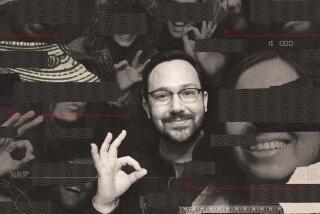Film Maker Brown to Appeal ‘The White Girl’s’ R Rating
- Share via
Last year, when British director Alan Parker battled the Motion Picture Assn. of America over the X rating given his film “Angel Heart,” skeptics from inside and outside the industry grumbled that it was just another controversy created to hype the box office.
Rating controversies do hype the box office, but if Alan Parker’s anger was insincere, he belongs in front of the camera, not behind it. And if the words that ratings board President Richard Heffner used to describe media coverage of that debate were used in a script, you could be sure the movie would get an automatic R.
For the record:
12:00 a.m. June 10, 1988 For the Record
Los Angeles Times Friday June 10, 1988 Home Edition Calendar Part 6 Page 10 Column 1 Entertainment Desk 1 inches; 23 words Type of Material: Correction
Richard Heffner, president of the Motion Picture Assn. of America’s ratings board, teaches at Rutgers University, not Columbia, as reported in Tuesday’s Calendar.
The integrity of the system is important when discussing first-time film maker Tony Brown’s “The White Girl.” If the sincerity of the ratings board were suspect, you might think the seven-member ratings panel went out of its way last week to help Brown launch his small, inoffensive and adamantly anti-drug film “The White Girl.”
“I cannot understand it and they won’t tell me anything about it except that, ‘It is too intense,’ ” Brown said of the panel’s R rating for “The White Girl.” “I said, ‘There is no nudity, no gratuitous violence, very little profanity. None of the things that get those strong ratings. What have I done wrong?’ ”
To Brown, the R rating is a rough introduction to the machinations of establishment Hollywood. The Howard University professor, syndicated columnist and host of the PBS show “Tony Brown’s Journal” spent $2 million producing the film and said he is fearful that, despite the notoriety, the R rating will squash it.
“The people I’m talking to in community groups around the country have to be concerned with ratings,” Brown said. “They go by the rules when deciding what to show their groups and whether the ratings make any sense, they are the rules.”
Heffner, a Columbia University professor and New York television show host, gave the standard MPAA line--”R doesn’t mean ‘rotten’ and PG doesn’t mean ‘pretty good’ “--and reiterated that policy prevents the board from discussing ratings decisions. He did say he respects Brown’s intentions with the film and added that he regards him as a friend.
“I’m glad you’re not a friend then,” Brown said, when Heffner’s comment was relayed to him. “I wouldn’t be able to believe anything you write about this.”
“The White Girl,” viewed privately through the courtesy of Brown, is essentially a morality play about a middle-class black college girl who becomes vulnerable to drug addiction because of family pressures placed on her to succeed among whites.
The film resembles an “Insight” Christian drama produced for Sunday morning television, showing one person’s battle with a private demon, cocaine. With the exception of one moderately strong slang word, “The White Girl” would seem to be as easily acceptable for general TV viewing.
“I can’t imagine that they are saddling this film with an R rating because there isn’t anything about it except those scenes dealing with drugs,” said Donnell Stoneman, a film critic for the Greensboro (N. C.) News and Record. “I wonder if the people voting on it have actually seen it.”
There is drug use throughout much of the film, but a person would have to be under the influence of something pretty strong to believe the film would encourage drug use. The ratings board may be alone in considering it too intense for viewing by unaccompanied teen-agers.
At the first public screening of “The White Girl” Thursday, a post-screening poll of the mostly professional audience in Chicago, taken at the request of Brown, found only nine of 300 people agreeing with the R rating.
“If I had an applause meter and asked for a voice vote, the theater would have exploded,” said Dr. Carl Bell, executive director of the sponsoring Community Mental Health Council in Chicago. “One of the educators said that it should be standard viewing for the Chicago public school system, grammar school and high school.”
Bell, a psychiatrist working with mental health patients in south Chicago, said the film is a perfect tool for the goal of “primary prevention”--exposing children to the dangers of drug abuse before they are exposed to drugs themselves.
“I would love to be in a health-education class in the Chicago public school system, show this movie, then sit around with the kids and discuss all the aspects,” Bell said. “I think it would be a very powerful vehicle for changing . . . behavior.”
Harold Brown, associate dean of the business school at San Diego State University, said he saw the film at a screening in Los Angeles several weeks ago and said he came to the opposite conclusion of the ratings board:
“It’s a film that teen-agers should see. We’re facing a bureaucratic stance (with the ratings board decision). ‘There’s a policy and we’re going to stick with it, whether it applies or not.’ ”
Tony Brown said he will appeal the R rating. He said he does not intend to release the film theatrically until next year and only submitted it now because many of the groups he is talking to about using it for fund-raisers have insisted on it.
“People believe in rules and whether the ratings make sense or not, they are the rules,” he said.
Brown is blunt about his commercial strategy for recovering his costs on “The White Girl.” He said he will recoup his $2 million from the 20% he receives from fund-raisers and will be in profit by the time it goes to theaters and videocassette. The Chicago screening was the first of 30 fund-raisers already scheduled, Brown said, and the first of 100 he expects to be held.
In the meantime, he said he is concerned about the damage the R rating may do and aware that he may benefit from a windfall of publicity.
“I haven’t been able to get my name mentioned in (the Hollywood trade paper) Variety before, so it has helped,” he said. “But I sure didn’t expect it. I wasn’t sure whether I would get a PG or a PG-13. When I got the R, I was flabbergasted.”
More to Read
Only good movies
Get the Indie Focus newsletter, Mark Olsen's weekly guide to the world of cinema.
You may occasionally receive promotional content from the Los Angeles Times.










